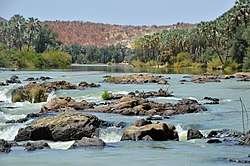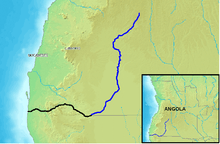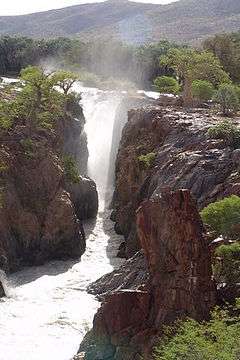Cunene River
| Cunene River | |
|---|---|
 Cunene River near Epupa Falls | |
 Course of the Kunene River, parts in Angola highlighted in blue | |
| Other name(s) | Kunene River |
| Physical characteristics | |
| Main source | Angolan Highlands |
| River mouth |
Atlantic Ocean 0 m (0 ft) 17°15′09″S 11°45′05″E / 17.25250°S 11.75139°ECoordinates: 17°15′09″S 11°45′05″E / 17.25250°S 11.75139°E |
| Length | 1,050 km (650 mi) |
| Discharge |
|
| Basin features | |
| Basin size | 106,560 km2 (41,140 sq mi) |
| Waterfalls | Epupa Falls |
The Cunene River (Portuguese spelling) or Kunene River (Namibian spelling) is a river in Southern Africa. It flows from the Angola highlands south to the border with Namibia. It then flows west along the border until it reaches the Atlantic Ocean. It is one of the few perennial rivers in the region. It is about 1,050 kilometres (652 mi) long, with a drainage basin 106,560 square kilometres (41,143 sq mi) in area. Its mean annual discharge is 174 m³/s (6,145 cfs) at its mouth.[1] The Epupa Falls lie on the river. Olushandja Dam dams a tributary of the river, the Etaka, and helps provide the Ruacana Power Station with water.
Controversy and Dams
The Namibian government proposed in the late 90's to build the Epupa Dam, a controversial hydroelectric dam on the Cunene. In 2012 the Governments of Namibia and Angola announced plans to jointly build the Orokawe dam in the Baynes Mountains. According to the indigenous Himba who would have been most affected by the construction of the dam, the dam threatens the local ecosystem and therefore the economic basis of the Himba. During February 2012, traditional Himba chiefs issued a declaration to the African Union and to the United Nations Human Rights Council of the United Nations, titled "Declaration of the most affected Ovahimba, Ovatwa, Ovatjimba and Ovazemba against the Orokawe Dam in the Baynes Mountains," which outlines the fierce objections against the dam from the traditional Himba chiefs and communities that reside near the Kunene River.[2][3][4]
September 2012, the United Nations Special Rapporteur on the Rights of Indigenous Peoples visited the Himba, and heard their concerns.
November 23, 2012, hundreds of Himba and Zemba from Omuhonga and Epupa region protested in Okanguati against Namibia’s plans to construct a dam in the Kunene River in the Baynes Mountains, against increasing mining operations on their traditional land and human rights violations against them.[5]
March 25, 2013, over thousand Himba and Zemba people marched in Opuwo[6] to protest again against Namibia's plans to build the Orokawe dam in the Baynes Mountains at the Cunene River without consulting with the indigenous peoples that do not consent to the construction plans.[7]
Attraction
Tourists frequent campsites or lodges in Epupa which offer water sports on the river including rafting and canoeing.[8] There are ancient baobab trees alongside the gorge, and there is an attractive and well-kept viewpoint high above the village and falls, but both are spoiled by broken bottles and abundant garbage.
References
- C.Michael Hogan. 2012. Kunene River. eds. P. Saundry & C. Cleveland. Encyclopedia of Earth. National Council for Science and the Environment. Washington DC.
- F.C.de Moor, H.M.Barber-James, A.D.Harrison, C.R.Lugo-Ortiz. 2000. The macroinvertebrates of the Cunene River from the Ruacana Falls to the river mouth and assessment of the conservation status of the river. African Journal of Aquatic Science. Vol.25, no.1
- Mikiyasu Nakayama. 2003. International Waters in Southern Africa. United Nations University Press. ISBN 92-808-1077-4. Google eBook
Line notes
- ↑ Nakayama, Mikiyasu (2003). International Waters in Southern Africa. United Nations University Press. p. 9. ISBN 92-808-1077-4. ; online at Google Books
- ↑ "Indigenous Himba Appeal to UN to Fight Namibian Dam". galdu.org. Retrieved 2012-04-06.
- ↑ "Namibian Minority Groups Demand Their Rights". newsodrome.com. Archived from the original on 2013-10-17. Retrieved 2012-04-06.
- ↑ "Declaration of the most affected Ovahimba, Ovatwa, Ovatjimba and Ovazemba against the Orokawe Dam in the Baynes Mountains". earthpeoples.org. Retrieved 2012-04-06.
- ↑ "Namibia: Indigenous semi-nomadic Himba and Zemba march in protest against dam, mining and human rights violations". earthpeoples.org. Retrieved November 24, 2012.
- ↑ "German GIZ directly engaged with dispossessing indigenous peoples of their lands and territories in Namibia". earthpeoples.org. Retrieved March 30, 2013.
- ↑ "Himba, Zemba reiterate 'no' to Baynes dam". Catherine Sasman for The Namibian. Retrieved March 26, 2013.
- ↑ "Archived copy". Archived from the original on 2013-04-22. Retrieved 2013-03-23.
